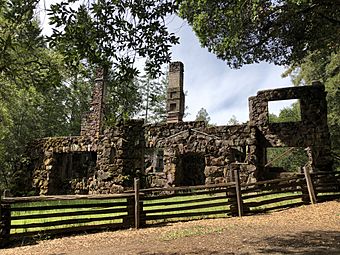Wolf House facts for kids
Quick facts for kids |
|
|
Wolf House
|
|
|
U.S. Historic district
Contributing property |
|

The ruins of the Wolf House
|
|
| Nearest city | Glen Ellen, California |
|---|---|
| Part of | Jack London State Historic Park (ID66000240) |
| Added to NRHP | October 15, 1966 |
The Wolf House was a huge, 26-room mansion in Glen Ellen, California. It was built by the famous writer Jack London and his wife Charmian London. Sadly, the house burned down on August 22, 1913, just before the Londons were going to move in. Today, the strong stone walls of the house still stand as ruins. They are part of Jack London State Historic Park, which has been a special National Historic Landmark since 1963.
Contents
Jack London's Dream Home
Jack London had a clear idea of his perfect house. In 1906, he wrote an essay called "The House Beautiful." In it, he described a dream home where usefulness and beauty worked together. He wanted a house that was honest in how it was built and what it looked like.
He imagined modern bathrooms, comfy spaces for helpers, and easy ways to clean. He also wanted good air flow and lots of fireplaces. London believed he would build this dream house in about seven to ten years.
Finding the Perfect Spot
Around 1905, London bought a 130-acre farm in the Sonoma Valley. He later bought more land nearby, making his farm about 1,200 acres in total. About one-third of the land was used for farming, and two-thirds were wooded hills. He called his property "Wonder Ranch."
Designing the Wolf House
London hired San Francisco architect Albert L. Farr to design his home. Farr was known for his "Arts and Crafts" style, which focused on natural materials and handmade quality. The Wolf House design was unique and looked very natural.
Cool Features of the House
The house was planned to have a huge library, about 19 by 40 feet. It also had a living room that was two stories high and measured 18 by 58 feet. London wanted modern things, so the plans included a water heater, electric lights, and even a built-in vacuum cleaning system! There were also laundry rooms and a wine cellar.
Because of the big 1906 San Francisco earthquake, London and Farr made sure the house would be very strong. The Wolf House was planned to be 15,000 square feet, with 26 rooms and nine fireplaces.
Building the Mansion
Building the Wolf House started in late 1910. Workers blasted stones and cut down trees. London hired an Italian stonemason named Natale Forni to lead the building team. His older sister, Eliza London Shepard, also helped manage the construction every day.
Local Building Materials
The house was built using five main materials, all found right there on the land. These included:
- Logs from Coast Redwood trees, with their bark still on.
- Large boulders.
- Chunks of volcanic rock dug from the ground.
- Blue Slate.
- Concrete.
The Mysterious Fire
The Wolf House was almost finished, and the Londons were getting ready to move in. But late on the night of August 22, 1913, a fire started. The fire spread very quickly and destroyed the inside of the house. However, the strong stone walls stayed standing. The red tile roof fell into the burned-out interior.
People thought someone might have started the fire on purpose, but no proof was ever found. The fire deeply affected everyone involved. Jack's sister Eliza cried that night. Charmian London later wrote that the fire "killed something in Jack." He always felt a sad sense of loss.
What Happened Next
The fire caused a lot of money to be lost. Jack London had insurance and received some money for the damage. He promised to rebuild the house. Workers even started cutting new redwood logs, but they needed to dry for 18 months before they could be used.
However, Jack London's health got worse. He passed away just over three years after the fire, on November 22, 1916.
The London Legacy
Charmian London continued to live at Beauty Ranch until she died in 1955. She lived in a home she called "The House of Happy Walls," which was about half a mile from the Wolf House ruins. There, she worked to keep her husband's memory alive and wrote a book about him. Her home is now a museum. Both Jack and Charmian London are buried at Beauty Ranch, along with Jack's sister Eliza.
In 1960, the London family gave the property to the State of California. The Wolf House ruins were recognized as a special historical place in 1959 and a National Historic Landmark in 1963. In 1965, steel supports were added to the walls to keep them from falling apart. Visitors can walk up to the outside walls of the ruins, but the inside is fenced off to protect it.
Solving the Fire Mystery
In 1995, a group of ten experts studied the fire to find out what caused it. They looked at many possibilities. It was a very hot day, but there was no lightning. They found no proof that someone started the fire on purpose, or that it was an electrical fire. The electricity system hadn't even been installed yet.
Instead, they found that the fire most likely started because of something called spontaneous combustion. Earlier that day, workers were putting a special oil finish on the beautiful oak and walnut wood inside the house. Workers had been warned before about being careful with these flammable materials. The fire probably began in cotton rags soaked with this oil, in the dining room on the ground floor. Some windows had not been put in yet, which let in air and helped the fire grow. By the time the fire was found, it was too big to control.



